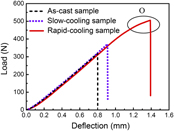Crossref Citations
This article has been cited by the following publications. This list is generated based on data provided by
Crossref.
Zhang, Zhihao
Wang, Wenping
Fu, Huadong
and
Xie, Jianxin
2011.
Effect of quench cooling rate on residual stress, microstructure and mechanical property of an Fe–6.5Si alloy.
Materials Science and Engineering: A,
Vol. 530,
Issue. ,
p.
519.
Xie, Jianxin
Fu, Huadong
Zhang, Zhihao
and
Jiang, Yanbin
2012.
Deformation twinning in an Fe-6.5 wt.% Si alloy with columnar grains during intermediate temperature compression.
Materials Science and Engineering: A,
Vol. 538,
Issue. ,
p.
315.
Xie, Jianxin
Fu, Huadong
Zhang, Zhihao
and
Jiang, Yanbin
2012.
Deformation twinning feature and its effects on significant enhancement of tensile ductility in columnar-grained Fe–6.5wt.%Si alloy at intermediate temperatures.
Intermetallics,
Vol. 23,
Issue. ,
p.
20.
Fu, Hua-dong
Zhang, Zhi-hao
Pan, Hong-jiang
Mo, Yuan-ke
and
Xie, Jian-xin
2013.
Warm/cold rolling processes for producing Fe-6.5wt% Si electrical steel with columnar grains.
International Journal of Minerals, Metallurgy, and Materials,
Vol. 20,
Issue. 6,
p.
535.
Fu, Huadong
Zhang, Zhihao
Wu, Xuesong
and
Xie, Jianxin
2013.
Effects of boron on microstructure and mechanical properties of Fe-6.5 wt.%Si alloy fabricated by directional solidification.
Intermetallics,
Vol. 35,
Issue. ,
p.
67.
Mo, Yuanke
Zhang, Zhihao
Fu, Huadong
Pan, Hongjiang
and
Xie, Jianxin
2014.
Effects of deformation temperature on the microstructure, ordering and mechanical properties of Fe–6.5wt% Si alloy with columnar grains.
Materials Science and Engineering: A,
Vol. 594,
Issue. ,
p.
111.
Mo, Yuan-ke
Zhang, Zhi-hao
Xie, Jian-xin
Fu, Hua-dong
and
Pan, Hong-jiang
2015.
Improved cold rolling workability of warm rolled Fe-6.5wt%Si electrical steel with columnar grains by annealing.
International Journal of Minerals, Metallurgy, and Materials,
Vol. 22,
Issue. 11,
p.
1171.
Li, Hui
Liang, Yong-Feng
and
Ye, Feng
2015.
Effect of Heat Treatment on Ordered Structures and Mechanical Properties of Fe-6.5 mass%Si Alloy.
MATERIALS TRANSACTIONS,
Vol. 56,
Issue. 5,
p.
759.
Li, Changsheng
Cai, Guojun
Cai, Ban
and
Wang, Qiwen
2016.
Impact of rolling temperature on microstructure, ordered phases, and ductility in Fe–6.5 wt% Si magnetic material.
Journal of Materials Research,
Vol. 31,
Issue. 19,
p.
3004.
Fu, Huadong
Mo, Yuanke
Zhang, Zhihao
and
Xie, Jianxin
2016.
Ultra-low deformation rate sensitivity of columnar-grained Fe-6.5 wt%Si alloy with 〈100〉 orientation.
Materials Science and Engineering: A,
Vol. 656,
Issue. ,
p.
90.
Fu, Hua-dong
Mo, Yuan-ke
Zhuo, Long-chao
Zhang, Zhi-hao
and
Xie, Jian-xin
2016.
Effect of warm rolling on micro-deformation behavior and mechanical properties of columnar-grained Fe-6. 5 mass % Si alloy.
Journal of Iron and Steel Research International,
Vol. 23,
Issue. 3,
p.
225.
Cai, Guojun
Li, Changsheng
Cai, Ban
and
Wang, Qiwen
2016.
Effects of warm rolling reduction on the microstructure, texture and magnetic properties of Fe–6.5 wt% Si steel.
Journal of Materials Research,
Vol. 31,
Issue. 12,
p.
1773.
Fu, Hua-dong
Mo, Yuan-ke
Zhuo, Long-chao
Zhang, Zhi-hao
and
Xie, Jian-xin
2016.
Effect of deformation temperature on deformation mechanism of Fe-6.5Si alloys with different initial microstructures.
Journal of Iron and Steel Research International,
Vol. 23,
Issue. 4,
p.
344.
Lemke, J.N.
Simonelli, M.
Garibaldi, M.
Ashcroft, I.
Hague, R.
Vedani, M.
Wildman, R.
and
Tuck, C.
2017.
Calorimetric study and microstructure analysis of the order-disorder phase transformation in silicon steel built by SLM.
Journal of Alloys and Compounds,
Vol. 722,
Issue. ,
p.
293.
Cai, Guojun
Li, Changsheng
Cai, Ban
and
Wang, Qiwen
2017.
An investigation on the role of texture evolution and ordered phase transition in soft magnetic properties of Fe–6.5 wt%Si electrical steel.
Journal of Magnetism and Magnetic Materials,
Vol. 430,
Issue. ,
p.
70.
Xu, Lili
and
Yan, Biao
2017.
Fe–6.5% Si/SiO2 powder cores prepared by spark plasma sintering: Magnetic properties and sintering mechanism.
International Journal of Modern Physics B,
Vol. 31,
Issue. 16-19,
p.
1744011.
Ouyang, Gaoyuan
Jensen, Brandt
Tang, Wei
Dennis, Kevin
Macziewski, Chad
Thimmaiah, Srinivasa
Liang, Yongfeng
and
Cui, Jun
2018.
Effect of wheel speed on magnetic and mechanical properties of melt spun Fe-6.5 wt.% Si high silicon steel.
AIP Advances,
Vol. 8,
Issue. 5,
Cai, Guojun
Li, Changsheng
Cai, Ban
and
Wang, Qiwen
2018.
An experimental investigation on B2 phase transfer and grain boundary character on mechanical properties of rapidly cooled Fe–6.5 wt% Si alloy.
Journal of Materials Research,
Vol. 33,
Issue. 4,
p.
507.
Zhang, Zhi-hao
Wang, Jun-li
and
Fu, Hua-dong
2018.
Morphology and distribution of precipitates and their effects on compression cracks in Fe-6.5Si-0.02B electrical steel.
Journal of Iron and Steel Research International,
Vol. 25,
Issue. 1,
p.
99.
Liu, Chunmei
Zhong, Yunbo
Shen, Zhe
Dong, Licheng
Zheng, Tianxiang
Ren, Weili
Lei, Zuosheng
and
Ren, Zhongming
2019.
Magnetic field–dependent microstructure evolution and magnetic property of Fe–6.5 Si–0.05 B alloy during solidification.
Journal of Materials Research,
Vol. 34,
Issue. 24,
p.
4076.





